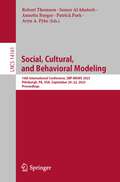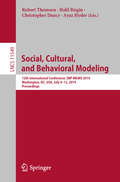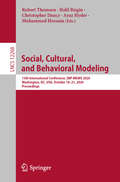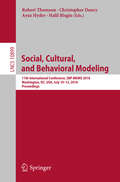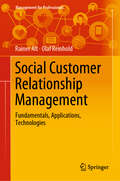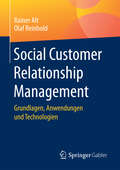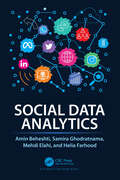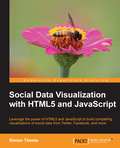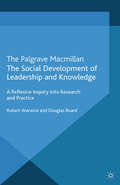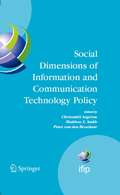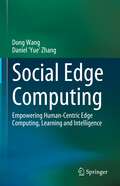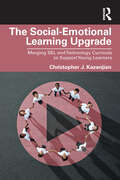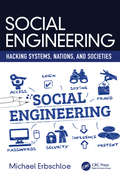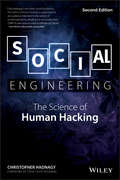- Table View
- List View
Social, Cultural, and Behavioral Modeling: 16th International Conference, SBP-BRiMS 2023, Pittsburgh, PA, USA, September 20–22, 2023, Proceedings (Lecture Notes in Computer Science #14161)
by Robert Thomson Samer Al-Khateeb Annetta Burger Patrick Park Aryn A. PykeThis book constitutes the proceedings of the 16th International Conference on Social, Cultural, and Behavioral Modeling, SBP-BRiMS 2023, which was held in Pittsburgh, PA, USA in September 2023.The 31 full papers presented in this volume were carefully reviewed and selected from 73 submissions. The papers were organized in topical sections as follows: Detecting malign influence; human behavior modeling; and social-cyber behavior modeling.
Social, Cultural, and Behavioral Modeling: 12th International Conference, SBP-BRiMS 2019, Washington, DC, USA, July 9–12, 2019, Proceedings (Lecture Notes in Computer Science #11549)
by Robert Thomson Halil Bisgin Christopher Dancy Ayaz HyderThis book constitutes the proceedings of the 12th International Conference on Social, Cultural, and Behavioral Modeling, SBP-BRiMS 2019, held in Washington, DC, USA, in July 2019. The total of 28 papers presented in this volume was carefully reviewed and selected from 72 submissions. The papers in this volume show, people, theories, methods and data from a wide number of disciplines including computer science, psychology, sociology, communication science, public health, bioinformatics, political science, and organizational science. Numerous types of computational methods are used include, but not limited to, machine learning, language technology, social network analysis and visualization, agent-based simulation, and statistics.
Social, Cultural, and Behavioral Modeling: 13th International Conference, SBP-BRiMS 2020, Washington, DC, USA, October 18–21, 2020, Proceedings (Lecture Notes in Computer Science #12268)
by Robert Thomson Halil Bisgin Christopher Dancy Ayaz Hyder Muhammad HussainThis book constitutes the proceedings of the 13th International Conference on Social, Cultural, and Behavioral Modeling, SBP-BRiMS 2020, which was planned to take place in Washington, DC, USA. Due to the COVID-19 pandemic the conference was held online during October 18–21, 2020. The 33 full papers presented in this volume were carefully reviewed and selected from 66 submissions. A wide number of disciplines are represented including computer science, psychology, sociology, communication science, public health, bioinformatics, political science, and organizational science. Numerous types of computational methods are used, such as machine learning, language technology, social network analysis and visualization, agent-based simulation, and statistics.
Social, Cultural, and Behavioral Modeling: 11th International Conference, SBP-BRiMS 2018, Washington, DC, USA, July 10-13, 2018, Proceedings (Lecture Notes in Computer Science #10899)
by Robert Thomson Christopher Dancy Ayaz Hyder Halil BisginThis book constitutes the proceedings of the 11th International Conference on Social, Cultural, and Behavioral Modeling, SBP-BRiMS 2018, held in Washington, DC, USA, in July 2018. The total of 27 short and 18 full papers presented in this volume was carefully reviewed and selected from 85 submissions. The contributions were organized in topical sections named: advances in sociocultural and behavioral process modeling; information, systems, and network science; applications for health and well-being; military and intelligence applications; cybersecurity.
Social, Cultural, and Behavioral Modeling: 15th International Conference, SBP-BRiMS 2022, Pittsburgh, PA, USA, September 20–23, 2022, Proceedings (Lecture Notes in Computer Science #13558)
by Robert Thomson Christopher Dancy Aryn PykeThis book constitutes the proceedings of the 15th International Conference on Social, Cultural, and Behavioral Modeling, SBP-BRiMS 2022, which was in Pittsburgh, PA, USA in September 2022.The 25 full papers presented in this volume were carefully reviewed and selected from 50 submissions. The papers were organized in topical sections as follows: computer science, psychology, sociology, communication science, public health, bioinformatics, political science, and organizational science. Numerous types of computational methods are used include, but not limited to, machine learning, language technology, social network analysis and visualization, agent-based simulation, and statistics.
Social, Cultural, and Behavioral Modeling: 14th International Conference, SBP-BRiMS 2021, Virtual Event, July 6–9, 2021, Proceedings (Lecture Notes in Computer Science #12720)
by Robert Thomson Muhammad Nihal Hussain Christopher Dancy Aryn PykeThis book constitutes the proceedings of the 14th International Conference on Social, Cultural, and Behavioral Modeling, SBP-BRiMS 2021, which was held online during July 6–9, 2021.The 32 full papers presented in this volume were carefully reviewed and selected from 56 submissions. The papers were organized in topical sections as follows: COVID-related focus; methodologies; social cybersecurity and social networks; and human and agent modeling. They represent a wide number of disciplines including computer science, psychology, sociology, communication science, public health, bioinformatics, political science, and organizational science. Numerous types of computational methods are used including, but not limited to, machine learning, language technology, social network analysis and visualization, agent-based simulation, and statistics.
Social, Cultural, and Behavioral Modeling: 17th International Conference, SBP-BRiMS 2024, Pittsburgh, PA, USA, September 18–20, 2024, Proceedings (Lecture Notes in Computer Science #14972)
by Robert Thomson Scott Renshaw Aryn Pyke Samer Al-Khateeb Annetta Burger Patrick Park Aravind HariharanThis book constitutes the proceedings of the 17th International Conference on Social, Cultural, and Behavioral Modeling, SBP-BRiMS 2024, which was held in Pittsburgh, PA, USA, during September 18–20, 2024. The 24 full papers presented in this volume were carefully reviewed and selected from 54 submissions. They are grouped into the following topics: advancements in tools and theory; data-driven approaches.
Social Customer Relationship Management: Fundamentals, Applications, Technologies (Management for Professionals)
by Rainer Alt Olaf ReinholdSocial media has received considerable attention, and many potential benefits, as well as concerns, are now being discussed. This book explores how social media can successfully support business processes in marketing, sales and service in the context of customer relationship management (CRM). It presents the fundamentals of Social CRM and shows how small and large companies alike have implemented it.In turn, the book presents analytic and operational software tools that offer features for enhancing and streamlining interactions with customers. The book concludes with an overview of essential design areas that businesses need to bear in mind when introducing social media into their CRM strategies. In this regard, it also points out key success factors, limitations, and data protection aspects.
Social Customer Relationship Management: Grundlagen, Anwendungen und Technologien
by Rainer Alt Olaf ReinholdDieses Buch zeigt wie die Verbindung von Social Media mit Customer Relationship Management (CRM) Perspektiven für Marketing, Verkauf und Service schafft. Es kombiniert dazu Grundlagenwissen und Fallbeispiele. Für das Social CRM identifizieren die Autoren vier Verwendungszwecke sowie drei Umsetzungsstufen und thematisieren auch Fragen der Datenerschließung und der Datenqualität. Es richtet sich sowohl an Praktiker als auch an Lehrende und Studierende.
Social Data Analytics
by Amin Beheshti Samira Ghodratnama Mehdi Elahi Helia FarhoodThis book is an introduction to social data analytics along with its challenges and opportunities in the age of Big Data and Artificial Intelligence. It focuses primarily on concepts, techniques and methods for organizing, curating, processing, analyzing, and visualizing big social data: from text to image and video analytics. It provides novel techniques in storytelling with social data to facilitate the knowledge and fact discovery. The book covers a large body of knowledge that will help practitioners and researchers in understanding the underlying concepts, problems, methods, tools and techniques involved in modern social data analytics. It also provides real-world applications of social data analytics, including: Sales and Marketing, Influence Maximization, Situational Awareness, customer success and Segmentation, and performance analysis of the industry. It provides a deep knowledge in social data analytics by comprehensively classifying the current state of research, by describing in-depth techniques and methods, and by highlighting future research directions. Lecturers will find a wealth of material to choose from for a variety of courses, ranging from undergraduate courses in data science to graduate courses in data analytics.
Social Data Analytics
by Amin Beheshti Samira Ghodratnama Mehdi Elahi Helia FarhoodThis book is an introduction to social data analytics along with its challenges and opportunities in the age of Big Data and Artificial Intelligence. It focuses primarily on concepts, techniques and methods for organizing, curating, processing, analyzing, and visualizing big social data: from text to image and video analytics. It provides novel techniques in storytelling with social data to facilitate the knowledge and fact discovery. The book covers a large body of knowledge that will help practitioners and researchers in understanding the underlying concepts, problems, methods, tools and techniques involved in modern social data analytics. It also provides real-world applications of social data analytics, including: Sales and Marketing, Influence Maximization, Situational Awareness, customer success and Segmentation, and performance analysis of the industry. It provides a deep knowledge in social data analytics by comprehensively classifying the current state of research, by describing in-depth techniques and methods, and by highlighting future research directions. Lecturers will find a wealth of material to choose from for a variety of courses, ranging from undergraduate courses in data science to graduate courses in data analytics.
Social Data Analytics: Collaboration for the Enterprise (The Morgan Kaufmann Series on Business Intelligence)
by Krish Krishnan Shawn P. RogersSocial Data Analytics is the first practical guide for professionals who want to employ social data for analytics and business intelligence (BI). This book provides a comprehensive overview of the technologies and platforms and shows you how to access and analyze the data. You'll explore the five major types of social data and learn from cases and platform examples to help you make the most of sentiment, behavioral, social graph, location, and rich media data. A four-step approach to the social BI process will help you access, evaluate, collaborate, and share social data with ease. You'll learn everything you need to know to monitor social media and get an overview of the leading vendors in a crowded space of BI applications. By the end of this book, you will be well prepared for your organization’s next social data analytics project.Provides foundational understanding of new and emerging technologies—social data, collaboration, big data, advanced analyticsIncludes case studies and practical examples of success and failuresWill prepare you to lead projects and advance initiatives that will benefit you and your organization
Social Data Visualization with HTML5 and JavaScript
by Simon TimmsThis book is a fast-paced guide full of step-by-step instructions that teach you how to visualize social data using HTML5 and JavaScript.This book is for developers who are excited about data and who want to share that excitement with others. Developers who are interested in the data which can be extracted from social networks will also find this book hugely beneficial.Readers should have a working knowledge of both JavaScript and HTML.
The Social Development of Leadership and Knowledge: A Reflexive Inquiry into Research and Practice
by R. Warwick D. BoardIn an increasingly complex and interconnected world, the authors make a case rich in theory and narrative for a new reflexive approach to real life situations. This approach (immersed reflexivity) draws on Pierre Bourdieu's logic of practice and the complexity sciences.
Social Dimensions of Information and Communication Technology Policy: Proceedings of the Eighth International Conference on Human Choice and Computers (HCC8), IFIP TC 9, Pretoria, South Africa, September 25-26, 2008 (IFIP Advances in Information and Communication Technology)
by Chrisanthi Avgerou Matthew L. Smith Peter Van Den BesselaarThis book constitutes the proceedings of the 8th International Conference on Human Choice and Computers held in Pretoria, South Africa. The IFIP series publishes state-of-the-art results in the sciences and technologies of information and communication. The scope of the series includes: foundations of computer science; software theory and practice; education; computer applications in technology; communication systems; systems modeling and optimization; information systems; computers and society; computer systems technology; security and protection in information processing systems; artificial intelligence; and human-computer interaction. Proceedings and post-proceedings of refereed international conferences in computer science and interdisciplinary fields are featured. These results often precede journal publication and represent the most current research. The principal aim of the IFIP series is to encourage education and the dissemination and exchange of information about all aspects of computing.
Social Dimensions of Organised Crime: Modelling the Dynamics of Extortion Rackets (Computational Social Sciences)
by Corinna Elsenbroich David Anzola Nigel GilbertThis book presents a multi-disciplinary investigation into extortion rackets with a particular focus on the structures of criminal organisations and their collapse, societal processes in which extortion rackets strive and fail and the impacts of bottom-up and top-down ways of fighting extortion racketeering. Through integrating a range of disciplines and methods the book provides an extensive case study of empirically based computational social science. It is based on a wealth of qualitative data regarding multiple extortion rackets, such as the Sicilian Mafia, an international money laundering organisation and a predatory extortion case in Germany. Computational methods are used for data analysis, to help in operationalising data for use in agent-based models and to explore structures and dynamics of extortion racketeering through simulations. In addition to textual data sources, stakeholders and experts are extensively involved, providing narratives for analysis and qualitative validation of models. The book presents a systematic application of computational social science methods to the substantive area of extortion racketeering. The reader will gain a deep understanding of extortion rackets, in particular their entrenchment in society and processes supporting and undermining extortion rackets. Also covered are computational social science methods, in particular computationally assisted text analysis and agent-based modelling, and the integration of empirical, theoretical and computational social science.
Social Edge Computing: Empowering Human-Centric Edge Computing, Learning and Intelligence
by Dong Wang Daniel 'Yue' ZhangThe rise of the Internet of Things (IoT) and Artificial Intelligence (AI) leads to the emergence of edge computing systems that push the training and deployment of AI models to the edge of networks for reduced bandwidth cost, improved responsiveness, and better privacy protection, allowing for the ubiquitous AI that can happen anywhere and anytime. Motivated by the above trend, this book introduces a new computing paradigm, the Social Edge Computing (SEC), that empowers human-centric edge intelligent applications by revolutionizing the computing, intelligence, and the training of the AI models at the edge. The SEC paradigm introduces a set of critical human-centric challenges such as the rational nature of edge device owners, pronounced heterogeneity of the edge devices, real-time AI at the edge, human and AI interaction, and the privacy of the edge users. The book addresses these challenges by presenting a series of principled models and systems that enable the confluence of the computing capabilities of devices and the domain knowledge of the people, while explicitly addressing the unique concerns and constraints from humans. Compared to existing books in the field of edge computing, the vision of this book is unique: we focus on the social edge computing (SEC), an emerging paradigm at the intersection of edge computing, AI, and social computing. This book discusses the unique vision, challenges and applications in SEC. To our knowledge, keeping humans in the loop of edge intelligence has not been systematically reviewed and studied in an existing book. The SEC vision generalizes the current machine-to-machine interactions in edge computing (e.g., mobile edge computing literature), and machine-to-AI interactions (e.g., edge intelligence literature) into a holistic human-machine-AI ecosystem.
The Social-Emotional Learning Upgrade: Merging SEL and Technology Curricula to Support Young Learners
by Christopher J. KazanjianThe Social-Emotional Learning Upgrade explores how today’s educators can connect two previously separated but important curricula in their schools: social-emotional learning (SEL) and educational technology. With schools’ SEL efforts pressed for time and resources and digital engagements often limited to skill development, K-12 students risk being unprepared to sustain their well-being and personal opportunities in a rapidly changing, technology-dependent world. Driven by a paradigm that synthesizes multicultural education and humanistic psychology, this book readies educators to implement SEL curricula that will support young learners as they navigate constant social and technological flux and that will nurture their unique perceptions of reality, their aspirations, and their mental and physical health. Each chapter’s novel insights will help to mitigate both student disengagement and teacher demoralization, enabling classroom pedagogies and the process of schooling to better align with the ways in which learners explore, express, and create meaning. Guiding pre-service teachers, leaders, and curriculum developers beyond common goals such as digital skills development, content mastery, or standardized testing, this volume focuses instead on complex digital literacies, collaborative experiences, problem- and project-based learning, culturally relevant pedagogies, and overall holistic growth.
The Social-Emotional Learning Upgrade: Merging SEL and Technology Curricula to Support Young Learners
by Christopher J. KazanjianThe Social-Emotional Learning Upgrade explores how today’s educators can connect two previously separated but important curricula in their schools: social-emotional learning (SEL) and educational technology. With schools’ SEL efforts pressed for time and resources and digital engagements often limited to skill development, K-12 students risk being unprepared to sustain their well-being and personal opportunities in a rapidly changing, technology-dependent world. Driven by a paradigm that synthesizes multicultural education and humanistic psychology, this book readies educators to implement SEL curricula that will support young learners as they navigate constant social and technological flux and that will nurture their unique perceptions of reality, their aspirations, and their mental and physical health. Each chapter’s novel insights will help to mitigate both student disengagement and teacher demoralization, enabling classroom pedagogies and the process of schooling to better align with the ways in which learners explore, express, and create meaning. Guiding pre-service teachers, leaders, and curriculum developers beyond common goals such as digital skills development, content mastery, or standardized testing, this volume focuses instead on complex digital literacies, collaborative experiences, problem- and project-based learning, culturally relevant pedagogies, and overall holistic growth.
Social Engineering: Hacking Systems, Nations, and Societies
by Michael ErbschloeThis book analyzes of the use of social engineering as a tool to hack random systems and target specific systems in several dimensions of society. It shows how social engineering techniques are employed well beyond what hackers do to penetrate computer systems. And it explains how organizations and individuals can socially engineer their culture to help minimize the impact of the activities of those who lie, cheat, deceive, and defraud. After reading this book, you’ll be able to analyze how organizations work and the need for security to maintain operations and sustainability, and be able to identify, respond to and counter socially engineered threats to security.
Social Engineering: Hacking Systems, Nations, and Societies
by Michael ErbschloeThis book analyzes of the use of social engineering as a tool to hack random systems and target specific systems in several dimensions of society. It shows how social engineering techniques are employed well beyond what hackers do to penetrate computer systems. And it explains how organizations and individuals can socially engineer their culture to help minimize the impact of the activities of those who lie, cheat, deceive, and defraud. After reading this book, you’ll be able to analyze how organizations work and the need for security to maintain operations and sustainability, and be able to identify, respond to and counter socially engineered threats to security.
Social Engineering: The Science of Human Hacking
by Christopher HadnagyHarden the human firewall against the most current threats Social Engineering: The Science of Human Hacking reveals the craftier side of the hacker’s repertoire—why hack into something when you could just ask for access? Undetectable by firewalls and antivirus software, social engineering relies on human fault to gain access to sensitive spaces; in this book, renowned expert Christopher Hadnagy explains the most commonly-used techniques that fool even the most robust security personnel, and shows you how these techniques have been used in the past. The way that we make decisions as humans affects everything from our emotions to our security. Hackers, since the beginning of time, have figured out ways to exploit that decision making process and get you to take an action not in your best interest. This new Second Edition has been updated with the most current methods used by sharing stories, examples, and scientific study behind how those decisions are exploited. Networks and systems can be hacked, but they can also be protected; when the “system” in question is a human being, there is no software to fall back on, no hardware upgrade, no code that can lock information down indefinitely. Human nature and emotion is the secret weapon of the malicious social engineering, and this book shows you how to recognize, predict, and prevent this type of manipulation by taking you inside the social engineer’s bag of tricks. Examine the most common social engineering tricks used to gain access Discover which popular techniques generally don’t work in the real world Examine how our understanding of the science behind emotions and decisions can be used by social engineers Learn how social engineering factors into some of the biggest recent headlines Learn how to use these skills as a professional social engineer and secure your company Adopt effective counter-measures to keep hackers at bay By working from the social engineer’s playbook, you gain the advantage of foresight that can help you protect yourself and others from even their best efforts. Social Engineering gives you the inside information you need to mount an unshakeable defense.
Social Engineering: The Science of Human Hacking
by Christopher HadnagyHarden the human firewall against the most current threats Social Engineering: The Science of Human Hacking reveals the craftier side of the hacker’s repertoire—why hack into something when you could just ask for access? Undetectable by firewalls and antivirus software, social engineering relies on human fault to gain access to sensitive spaces; in this book, renowned expert Christopher Hadnagy explains the most commonly-used techniques that fool even the most robust security personnel, and shows you how these techniques have been used in the past. The way that we make decisions as humans affects everything from our emotions to our security. Hackers, since the beginning of time, have figured out ways to exploit that decision making process and get you to take an action not in your best interest. This new Second Edition has been updated with the most current methods used by sharing stories, examples, and scientific study behind how those decisions are exploited. Networks and systems can be hacked, but they can also be protected; when the “system” in question is a human being, there is no software to fall back on, no hardware upgrade, no code that can lock information down indefinitely. Human nature and emotion is the secret weapon of the malicious social engineering, and this book shows you how to recognize, predict, and prevent this type of manipulation by taking you inside the social engineer’s bag of tricks. Examine the most common social engineering tricks used to gain access Discover which popular techniques generally don’t work in the real world Examine how our understanding of the science behind emotions and decisions can be used by social engineers Learn how social engineering factors into some of the biggest recent headlines Learn how to use these skills as a professional social engineer and secure your company Adopt effective counter-measures to keep hackers at bay By working from the social engineer’s playbook, you gain the advantage of foresight that can help you protect yourself and others from even their best efforts. Social Engineering gives you the inside information you need to mount an unshakeable defense.
Social Engineering in Cybersecurity: Threats and Defenses
by Dr Gururaj H L Dr Janhavi V Ambika VIn today’s digitally interconnected world, the threat landscape has evolved to include not just sophisticated technical exploits but also the art of human manipulation. Social engineering attacks have emerged as a formidable and often underestimated threat to information security. The primary aim of this textbook is to provide a comprehensive and in-depth exploration of social engineering attacks. The book seeks to equip cybersecurity professionals, IT practitioners, students, and anyone concerned with information security with the knowledge and tools needed to recognize, prevent, and mitigate the risks posed by social engineering. The scope of this textbook is broad and multifaceted. It covers a wide range of social engineering attack vectors, including phishing, vishing, pretexting, baiting, tailgating, impersonation, and more. Each attack vector is dissected, with detailed explanations of how they work, real-world examples, and countermeasures. Key Features • Comprehensive Coverage: Thorough exploration of various social engineering attack vectors, including phishing, vishing, pretexting, baiting, quid pro quo, tailgating, impersonation, and more. • Psychological Insights: In-depth examination of the psychological principles and cognitive biases that underlie social engineering tactics. • Real-World Case Studies: Analysis of real-world examples and high-profile social engineering incidents to illustrate concepts and techniques.• Prevention and Mitigation: Practical guidance on how to recognize, prevent, and mitigate social engineering attacks, including security best practices. • Ethical Considerations: Discussion of ethical dilemmas and legal aspects related to social engineering that emphasizes responsible use of knowledge. This comprehensive textbook on social engineering attacks provides a deep and practical exploration of this increasingly prevalent threat in cybersecurity. It covers a wide array of attack vectors, including phishing, vishing, pretexting, and more, offering readers an in-depth understanding of how these attacks work. The book delves into the psychology behind social engineering and examines the cognitive biases and emotional triggers that make individuals susceptible. Real-world case studies illustrate concepts and techniques while practical guidance equips readers with the knowledge to recognize, prevent, and mitigate social engineering threats.
Social Engineering in Cybersecurity: Threats and Defenses
In today’s digitally interconnected world, the threat landscape has evolved to include not just sophisticated technical exploits but also the art of human manipulation. Social engineering attacks have emerged as a formidable and often underestimated threat to information security. The primary aim of this textbook is to provide a comprehensive and in-depth exploration of social engineering attacks. The book seeks to equip cybersecurity professionals, IT practitioners, students, and anyone concerned with information security with the knowledge and tools needed to recognize, prevent, and mitigate the risks posed by social engineering. The scope of this textbook is broad and multifaceted. It covers a wide range of social engineering attack vectors, including phishing, vishing, pretexting, baiting, tailgating, impersonation, and more. Each attack vector is dissected, with detailed explanations of how they work, real-world examples, and countermeasures. Key Features • Comprehensive Coverage: Thorough exploration of various social engineering attack vectors, including phishing, vishing, pretexting, baiting, quid pro quo, tailgating, impersonation, and more. • Psychological Insights: In-depth examination of the psychological principles and cognitive biases that underlie social engineering tactics. • Real-World Case Studies: Analysis of real-world examples and high-profile social engineering incidents to illustrate concepts and techniques.• Prevention and Mitigation: Practical guidance on how to recognize, prevent, and mitigate social engineering attacks, including security best practices. • Ethical Considerations: Discussion of ethical dilemmas and legal aspects related to social engineering that emphasizes responsible use of knowledge. This comprehensive textbook on social engineering attacks provides a deep and practical exploration of this increasingly prevalent threat in cybersecurity. It covers a wide array of attack vectors, including phishing, vishing, pretexting, and more, offering readers an in-depth understanding of how these attacks work. The book delves into the psychology behind social engineering and examines the cognitive biases and emotional triggers that make individuals susceptible. Real-world case studies illustrate concepts and techniques while practical guidance equips readers with the knowledge to recognize, prevent, and mitigate social engineering threats.
